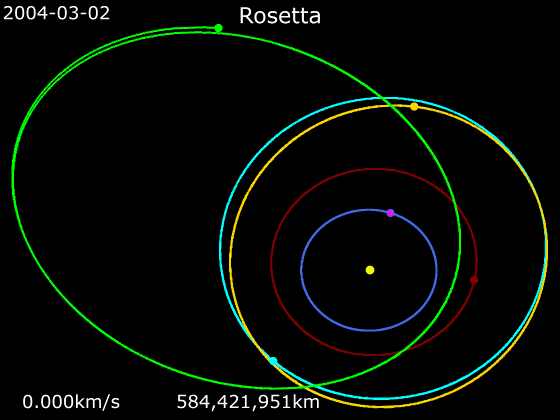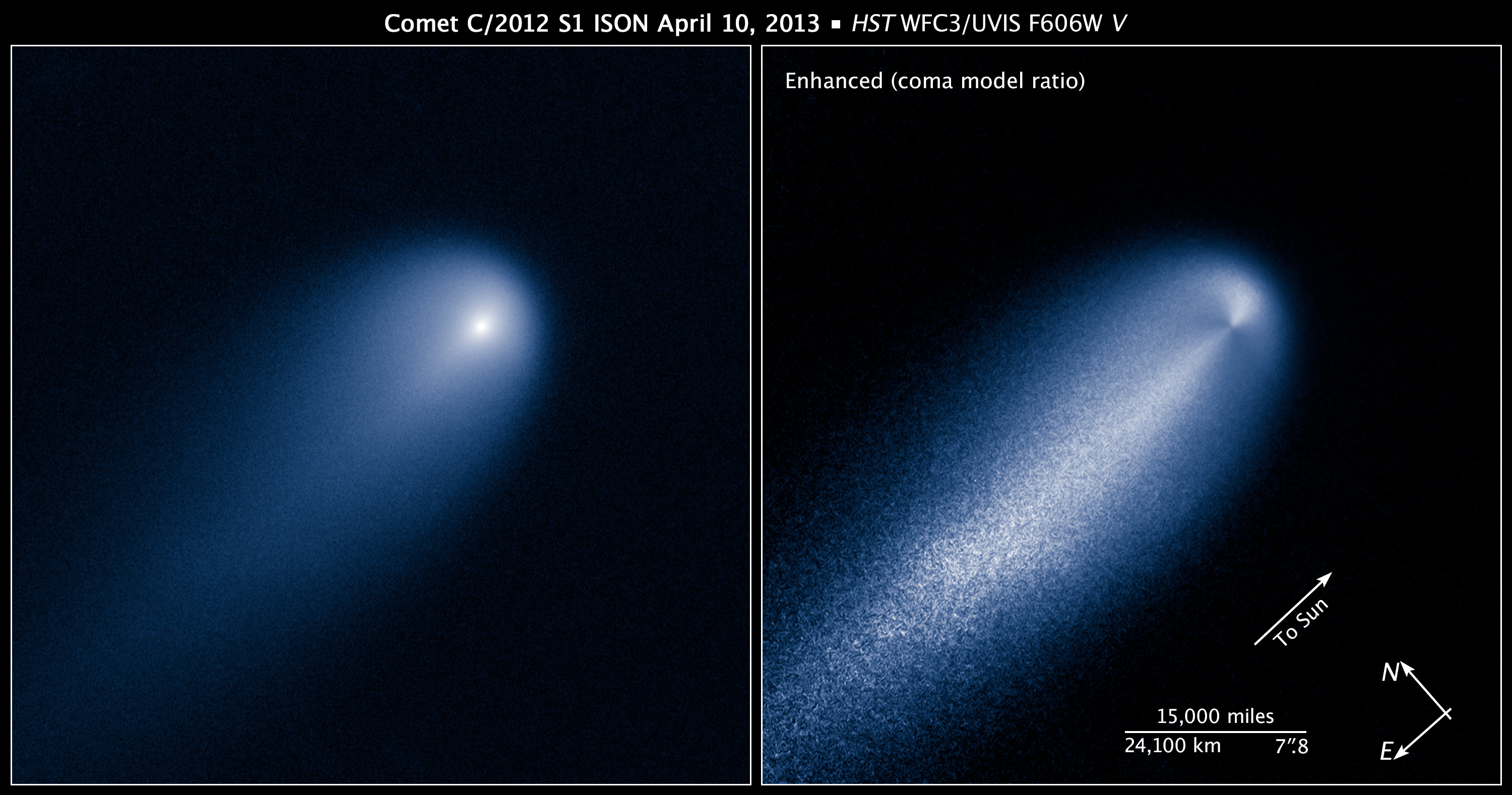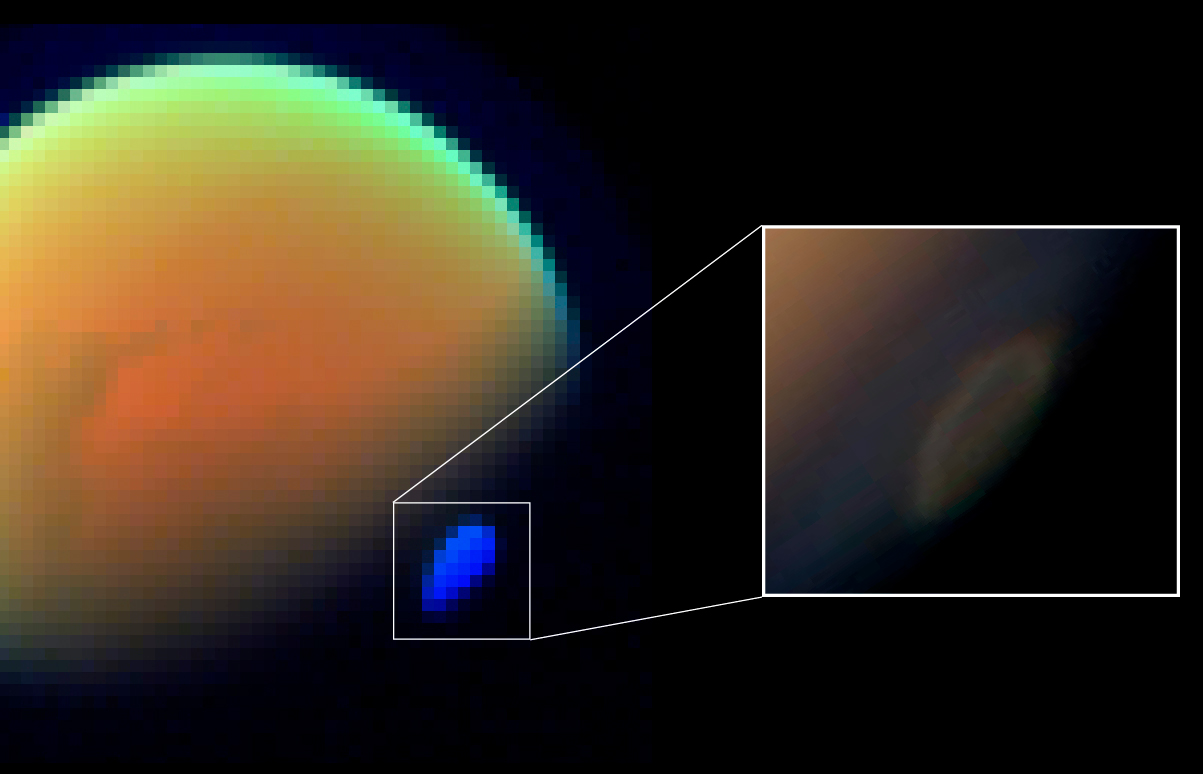 |
Coma (cometary)
The coma is the nebulous envelope around the nucleus of a comet, formed when the comet passes near the Sun in its highly elliptical orbit. As the comet warms, parts of it sublimate; this gives a comet a diffuse appearance when viewed through telescopes and distinguishes it from stars. The word ''coma'' comes from the Greek (), which means "hair" and is the origin of the word ''comet'' itself. The coma is generally made of ice and comet dust. Water composes up to 90% of the volatiles that outflow from the nucleus when the comet is within from the Sun. The H2O parent molecule is destroyed primarily through photodissociation and to a much smaller extent photoionization. The solar wind plays a minor role in the destruction of water compared to photochemistry. Larger dust particles are left along the comet's orbital path while smaller particles are pushed away from the Sun into the comet's tail by light pressure. On 11 August 2014, astronomers released studies, using the A ... [...More Info...] [...Related Items...] OR: [Wikipedia] [Google] [Baidu] |
 |
Infrared Structure Of Comet Holmes
Infrared (IR; sometimes called infrared light) is electromagnetic radiation (EMR) with wavelengths longer than that of visible light but shorter than microwaves. The infrared spectral band begins with the waves that are just longer than those of red light (the longest waves in the visible spectrum), so IR is invisible to the human eye. IR is generally (according to ISO, CIE) understood to include wavelengths from around to . IR is commonly divided between longer-wavelength thermal IR, emitted from terrestrial sources, and shorter-wavelength IR or near-IR, part of the solar spectrum. Longer IR wavelengths (30–100 μm) are sometimes included as part of the terahertz radiation band. Almost all black-body radiation from objects near room temperature is in the IR band. As a form of EMR, IR carries energy and momentum, exerts radiation pressure, and has properties corresponding to wave–particle duality, both those of a wave and of a subatomic particle, particle, the photon. I ... [...More Info...] [...Related Items...] OR: [Wikipedia] [Google] [Baidu] |
 |
Stardust (spacecraft)
''Stardust'' was a 385-kilogram robotic space probe launched by NASA on 7 February 1999. Its primary mission was to collect dust samples from the coma of comet Wild 2, as well as samples of cosmic dust, and return them to Earth for analysis. It was the first sample return mission of its kind. En route to Comet Wild 2, it also flew by and studied the asteroid 5535 Annefrank. The primary mission was successfully completed on 15 January 2006 when the sample return capsule returned to Earth. A mission extension, codenamed ''NExT'', culminated in February 2011 with ''Stardust'' intercepting Comet Tempel 1, a small Solar System body previously visited by '' Deep Impact'' in 2005. ''Stardust'' ceased operations in March 2011. On 14 August 2014, scientists announced the identification of possible interstellar dust particles from the ''Stardust'' capsule returned to Earth in 2006. Mission background History Beginning in the 1980s, scientists began seeking a dedicate ... [...More Info...] [...Related Items...] OR: [Wikipedia] [Google] [Baidu] |
|
67P/Churyumov–Gerasimenko
67P/Churyumov–Gerasimenko (abbreviated as 67P or 67P/C–G) is a Jupiter-family comet. It is originally from the Kuiper belt and has an orbital period of 6.45 years as of 2012, a rotation period of approximately 12.4 hours, and a maximum velocity of . Churyumov–Gerasimenko is approximately at its longest and widest dimensions. It was first observed on photographic plates in 1969 by Soviet astronomers Klim Churyumov, Klim Ivanovych Churyumov and Svetlana Gerasimenko, Svetlana Ivanovna Gerasimenko, after whom it is Naming of comets, named. It most recently came to Perihelion and aphelion, perihelion (closest approach to the Sun) on 2 November 2021, and will next come to perihelion on 9 April 2028. Churyumov–Gerasimenko was the destination of the European Space Agency's Rosetta (spacecraft), ''Rosetta'' mission, launched on 2 March 2004. ''Rosetta'' space rendezvous, rendezvoused with Churyumov–Gerasimenko on 6 August 2014 and entered orbit on 10 September 2014. ''Rosetta' ... [...More Info...] [...Related Items...] OR: [Wikipedia] [Google] [Baidu] |
|
 |
Rosetta (spacecraft)
''Rosetta'' was a space probe built by the European Space Agency that launched on 2 March 2004. Along with ''Philae'', its lander module, ''Rosetta'' performed a detailed study of comet 67P/Churyumov–Gerasimenko (67P). During its journey to the comet, the spacecraft performed flybys of Earth, Mars, and the asteroids 21 Lutetia and 2867 Šteins. It was launched as the third cornerstone mission of the ESA's Horizon 2000 programme, after ''SOHO' Cluster'' and '' XMM-Newton''. On 6 August 2014, the spacecraft reached the comet and performed a series of manoeuvers to eventually orbit the comet at distances of . On 12 November, its lander module ''Philae'' performed the first successful landing on a comet, though its battery power ran out two days later. Communications with ''Philae'' were briefly restored in June and July 2015, but due to diminishing solar power, ''Rosetta'' communications module with the lander was turned off on 27 July 2016. On 30 September 2016, the ''Rosett ... [...More Info...] [...Related Items...] OR: [Wikipedia] [Google] [Baidu] |
|
The Astrophysical Journal
''The Astrophysical Journal'' (''ApJ'') is a peer-reviewed scientific journal of astrophysics and astronomy, established in 1895 by American astronomers George Ellery Hale and James Edward Keeler. The journal discontinued its print edition and became an electronic-only journal in 2015. Since 1953, ''The Astrophysical Journal Supplement Series'' (''ApJS'') has been published in conjunction with ''The Astrophysical Journal'', with generally longer articles to supplement the material in the journal. It publishes six volumes per year, with two 280-page issues per volume. ''The Astrophysical Journal Letters'' (''ApJL''), established in 1967 by Subrahmanyan Chandrasekhar as Part 2 of ''The Astrophysical Journal'', is now a separate journal focusing on the rapid publication of high-impact astronomical research. The three journals were published by the University of Chicago Press for the American Astronomical Society until, in January 2009, publication was transferred to IOP Publis ... [...More Info...] [...Related Items...] OR: [Wikipedia] [Google] [Baidu] |
|
 |
Comet ISON
Comet ISON, formally known as C/2012 S1, was a sungrazing comet from the Oort cloud which was discovered on 21 September 2012 by Vitaly Nevsky (Віталь Неўскі, Vitebsk, Belarus) and Artyom Novichonok (Артём Новичонок, Kondopoga, Russia). History The discovery was made using the reflecting telescope, reflector of the International Scientific Optical Network (ISON) near Kislovodsk, Russia. Data processing was carried out by automated asteroid-discovery program CoLiTec. Precovery images by the Mount Lemmon Survey from 28 December 2011 and by Pan-STARRS from 28 January 2012 were quickly located. Follow-up observations were made on 22 September 2012 by a team from Remanzacco Observatory in Italy using the iTelescope network. The discovery was announced by the Minor Planet Center on 24 September. Observations by Swift Gamma-Ray Burst Mission, Swift in January 2013 suggested that Comet ISON's comet nucleus, nucleus was around in diameter. Later estimates wer ... [...More Info...] [...Related Items...] OR: [Wikipedia] [Google] [Baidu] |
|
C/2012 F6 (Lemmon)
C/2012 F6 (Lemmon) is a long-period comet discovered in Leo on 23 March 2012, by A. R. Gibbs using the 1.5-m reflector at the Mt. Lemmon Survey, located at the summit of Mount Lemmon in the Santa Catalina Mountains north of Tucson, Arizona, USA. Initially, the object was considered to be of asteroidal nature before later observations confirmed its cometary appearance. Comet Lemmon has a highly eccentric orbit, bringing it as close to 0.73 AU from the Sun at perihelion and as far as 973 AU from the Sun at aphelion. This also leads to the comet's long-period nature with an orbital period of approximately 8,000 years based on epoch 2050. The comet last reached perihelion on 24 March 2013. For much of 2012, observation of Lemmon remained limited to CCD imagery, but steadily brightened throughout the course of the year. In late-November 2012, the comet became bright enough for telescopic viewing, and had an apparent magnitude estimated at +9 by the year's en ... [...More Info...] [...Related Items...] OR: [Wikipedia] [Google] [Baidu] |
|
 |
Dust
Dust is made of particle size, fine particles of solid matter. On Earth, it generally consists of particles in the atmosphere that come from various sources such as soil lifted by wind (an aeolian processes, aeolian process), Types of volcanic eruptions, volcanic eruptions, and pollution. Dust in homes is composed of about 20–50% dead skin Cell (biology), cells. The rest, and in offices and other built environments, is composed of small amounts of plant pollen, human hairs, animal fur, textile fibers, paper fibers, minerals from outdoor soil, burnt meteorite particles, and many other materials which may be found in the local environment. Atmospheric Atmospheric or wind-borne fugitive dust, also known as ''aeolian dust'', comes from dry regions where high-speed winds can remove mostly silt-sized material, abrading susceptible surfaces. This includes areas where grazing, ploughing, vehicle use, and other human behaviors have further destabilized the land, though not all so ... [...More Info...] [...Related Items...] OR: [Wikipedia] [Google] [Baidu] |
|
Formaldehyde
Formaldehyde ( , ) (systematic name methanal) is an organic compound with the chemical formula and structure , more precisely . The compound is a pungent, colourless gas that polymerises spontaneously into paraformaldehyde. It is stored as aqueous solutions (formalin), which consists mainly of the hydrate CH2(OH)2. It is the simplest of the aldehydes (). As a precursor to many other materials and chemical compounds, in 2006 the global production of formaldehyde was estimated at 12 million tons per year. It is mainly used in the production of industrial resins, e.g., for particle board and coatings. Formaldehyde also occurs naturally. It is derived from the degradation of serine, dimethylglycine, and lipids. Demethylases act by converting N-methyl groups to formaldehyde. Formaldehyde is classified as a group 1 carcinogen and can cause respiratory and skin irritation upon exposure. Forms Formaldehyde is more complicated than many simple carbon compounds in that i ... [...More Info...] [...Related Items...] OR: [Wikipedia] [Google] [Baidu] |
|
|
Hydrogen Isocyanide
Hydrogen isocyanide is a chemical with the molecular formula HNC. It is a minor tautomer of hydrogen cyanide (HCN). Its importance in the field of astrochemistry is linked to its ubiquity in the interstellar medium. Nomenclature Both ''hydrogen isocyanide'' and ''azanylidyniummethanide'' are correct IUPAC names for HNC. There is no preferred IUPAC name. The second one is according to the '' substitutive nomenclature rules'', derived from the '' parent hydride'' azane () and the anion methanide (). Molecular properties Hydrogen isocyanide (HNC) is a linear triatomic molecule with C∞v point group symmetry. It is a zwitterion and an isomer of hydrogen cyanide (HCN). Both HNC and HCN have large, similar dipole moments, with ''μ''HNC = 3.05 Debye and ''μ''HCN = 2.98 Debye respectively. These large dipole moments facilitate the easy observation of these species in the interstellar medium. HNC−HCN tautomerism As HNC is higher in energy than HCN by ... [...More Info...] [...Related Items...] OR: [Wikipedia] [Google] [Baidu] |
|
 |
Hydrogen Cyanide
Hydrogen cyanide (formerly known as prussic acid) is a chemical compound with the chemical formula, formula HCN and structural formula . It is a highly toxic and flammable liquid that boiling, boils slightly above room temperature, at . HCN is produced on an industrial scale and is a highly valued Precursor (chemistry), precursor to many chemical compounds ranging from polymers to pharmaceuticals. Large-scale applications are for the production of potassium cyanide and adiponitrile, used in mining and plastics, respectively. It is more toxic than solid cyanide compounds due to its Volatility (chemistry), volatile nature. A solution of hydrogen cyanide in water (molecule), water, represented as HCN(aqueous, aq), is called ''hydrocyanic acid''. The Salt (chemistry), salts of the cyanide anion are known as cyanides. Whether hydrogen cyanide is an organic compound or not is a topic of debate among chemists, and opinions vary from author to author. Traditionally, it is considered ino ... [...More Info...] [...Related Items...] OR: [Wikipedia] [Google] [Baidu] |
 |
Atacama Large Millimeter Array
The Atacama Large Millimeter/submillimeter Array (ALMA) is an astronomical interferometer of 66 radio telescopes in the Atacama Desert of northern Chile, which observe electromagnetic radiation at millimeter and submillimeter wavelengths. The array has been constructed on the elevation Chajnantor plateau – near the Llano de Chajnantor Observatory and the Atacama Pathfinder Experiment. This location was chosen for its high elevation and low humidity, factors which are crucial to reduce noise and decrease signal attenuation due to Earth's atmosphere. ALMA provides insight on star birth during the early Stelliferous era and detailed imaging of local star and planet formation. ALMA is an international partnership amongst Europe, the United States, Canada, Japan, South Korea, Taiwan, and Chile. Costing about US$1.4 billion, it is the most expensive ground-based telescope in operation. ALMA began scientific observations in the second half of 2011 and the first images were rel ... [...More Info...] [...Related Items...] OR: [Wikipedia] [Google] [Baidu] |